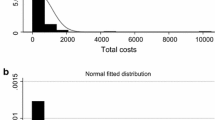Abstract
Objective: The choice of evidence used in decision modelling of healthcare interventions divides analysts into 2 groups: (i) those who favour randomised clinical trial (RCT) data; and (ii) those who prefer ‘real world’ data. This preference may have serious consequences if the end result is to inform healthcare policy. This paper uses Medicare coverage of epoetin-α [erythropoietin (EPO)] as a case study to illustrate a technique which can be used to overcome some of the bias inherent in RCT data while avoiding some of the common pitfalls associated with the use of observational data.
Design and setting: Cost analysis of 2 treatments for anaemia of renal failure primarily in an outpatient setting is modelled in a decision tree. This method can be used to analyse healthcare interventions or policies in any setting.
Patients and participants: Patients with nontransplanted end-stage renal disease (ESRD) who received either EPO or blood transfusion for treatment of anaemia at any time during the 1-year study period (July 1989 to June 1990) were included in the sample.
Methods: Outcome effects in the natural setting are decomposed into 2 parts: a treatment effect and a population effect. This is then extended to the special case of policy analysis. Logistic and multiple regression are used to estimate branch probabilities and payoffs, respectively, for 2 treatment options.
Main outcome measures and results: Under standard methods of decision analysis, an increase of $US7032 per patient following EPO coverage is observed. With the decomposition technique, the policy effect is estimated to be less, $US6172, the difference coming from the population effect.
Conclusions: Failure to remove population effects from observed outcome effects may lead to biased decision-making. Although not directly observable, the population effect can be imputed from secondary data. The decomposition and imputing technique allows for a more meaningful interpretation of the results for the purpose of policy analysis.
Similar content being viewed by others
References
Halpern MT, Luce BR, Brown RE, et al. Health and economic outcomes modeling practices: a suggested framework. Value Health 1998; 1 (2): 131–47
Kinosian B, Glick H. Clinical trials and external validity. Value Health 1998; 1 (3): 181–6
Dart A, Jerums G, Nicholson G, et al. A multi-center, doubleblind, one-year study comparing safety and efficacy of atorvastatin versus simvastatin in patients with hypercholesterolemia. Am J Cardiol 1997; 80 (1): 39–44
Shepherd J, Cobbe SM, Ford I, et al. Prevention of coronary heart disease with pravastatin in men with hypercholesterolemia: West Scotland Coronary Prevention Study Group. N Engl J Med 1995; 333: 1301–7
Pedersen TR, Kjekshus J, Berg K, et al. Cholesterol lowering and the use of healthcare resources: results of the Scandinavian Simvastatin Survival Study. Circulation 1996; 93 (10): 1796–802
Sacks FM, Pfeffer MA, Moye LA, et al. The effect of pravastatin on coronary events after mycardial infarction in patients with average cholesterol levels. N Engl J Med 1996; 335: 1001–9
US Renal Data System (USRDS). Chapter 2: incidence and prevalence of ESRD. 1997 Annual Data Report [online]. Available from: URL: http://www.med.umich.edu/usrds/chapters/ch02/ch02.html [accessed 1998 May 3]
Health Care Financing Review Medicare and Medicaid Statistical Supplement 1996. Baltimore (MD): US Department of Health and Human Services, Health Care Financing Administration, Office of Research and Demonstrations, 1997
Watson AJ. Adverse effects of therapy for the correction of anaemia in hemodialysis patients. Semin Nephrol 1989; 9 (1 Suppl. 1): 30–3
Powe NR, Griffiths RI, Bass EB. Cost implications to Medicare of recombinant erythropoietin therapy for the anaemia of endstage renal disease. J Am Soc Nephrol 1993; 3 (10): 1660–71
Juhn C, Murphy KM, Pierce B. Wage inequality and the rise in returns to skill. J Political Econ 1993; 101 (3): 410–42
Cotton J. On the decomposition of wage differentials. Rev Econ Stat 1988; 70 (2): 236–54
Reimers CW. Labor market discrimination against Hispanic and Black men. Rev Econ Stat 1983; 65 (4): 570–9
Johnson JA, Friesen F. Reassessing the relevance of pharmacoeconomic analyses in formulary decisions. Pharmacoeconomics 1998; 13 (5 Pt 1): 479–85
Eschbach JW, Egrie JC, Downing MR, et al. Correction of the anaemia of end-stage renal disease with recombinant human erythropoietin: results of a combined phase I and II clinical trial. N Engl J Med 1987; 316 (2): 73–8
Kirlin L. Case management of the anemic patient. Epoetin alfa: focus on hematocrit. ANNA J 1992; 19 (1): 66–7
Ifudu O, Macey LA, Friedman EA. Resurgence of blood transfusion therapy in erythropoietin treated hemodialysis patients. ASAIO J 1995; 41 (3): M426–30
US Renal Data System (USRDS). Chapter 10: the economic cost of ESRD, vascular access procedures, and Medicare spending for alternative modalities of treatment. 1998 Annual Data Report [online]. Available from: URL: http://www.med.umich.edu/usrds/chapters/ch10/ch10.html [accessed 1998 May 3]
US Renal Data System (USRDS). Chapter 0: executive summary. 1998 Annual Data Report [online]. Available from: URL: http://www.med.umich.edu/usrds/chapters/ch00/ch00.html [accessed 1999 Mar 24]
Author information
Authors and Affiliations
Corresponding author
Additional information
Work conducted while an employee at the Division of Pharmaceutical Policy and Evaluative Sciences, School of Pharmacy, University of North Carolina, Chapel Hill, North Carolina, USA
Rights and permissions
About this article
Cite this article
Shih, YC.T., Kauf, T.L. Reconciling Decision Models With the Real World. Pharmacoeconomics 15, 481–493 (1999). https://doi.org/10.2165/00019053-199915050-00006
Published:
Issue Date:
DOI: https://doi.org/10.2165/00019053-199915050-00006




